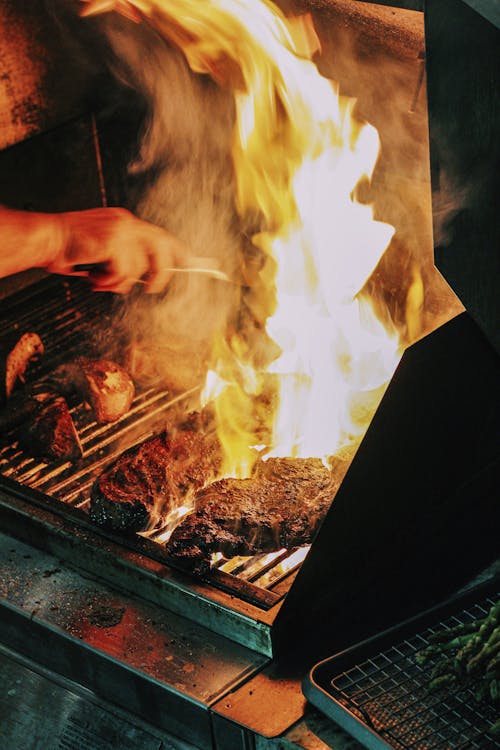When most people pick charcoal for grilling, they tend to focus on three key features: burn time, maximum temperature, and the size of the lumps. These are all important — no doubt about that. A longer burn means less hassle, high temperatures give you those gorgeous grill marks, and large, uniform lumps offer better airflow and control. But there's one factor that most grillers overlook — and it’s arguably the most important of them all: flavour.
Yes, flavour. That rich, smoky character that turns a simple steak into an unforgettable meal. The hidden ingredient in every mouthwatering burger, skewer, and rib rack. Flavour is where the real magic happens — and your choice of charcoal plays a much bigger role than you might think.
Charcoal Isn’t Just Fuel — It’s an Ingredient
Here’s something most people don’t realize: when you're grilling, you're not just cooking your food over heat — you're cooking it over a chemical reaction. As charcoal burns, it doesn’t just release heat; it also emits gases, particles, and aromatic compounds that interact with your meat. These compounds are carried by the smoke and absorbed by the surface of the food, layering on subtle (and sometimes not-so-subtle) flavours that no seasoning or sauce can replicate.
Different types of wood release different volatile compounds when turned into charcoal. Some of these enhance sweetness, some bring a deep, earthy undertone, while others give you that bold, savory smokiness that makes your neighbors peek over the fence.
The method of production matters too. Traditional lump charcoal, made by slowly carbonizing wood in low-oxygen environments, retains far more of its natural aromatic oils compared to cheap, fast-burned briquettes. If you're using poor-quality charcoal, you're not just compromising on heat — you're missing out on flavour.
Not All Charcoal is Created Equal
Let’s talk specifics. At our company, we focus on three premium hardwoods: birch, apple, and oak. Each one offers a different character, letting you match the charcoal to the type of dish you’re cooking — or the mood you want to set.
Birch Charcoal
Clean, crisp, and subtly sweet. Birch charcoal burns hot and fast, making it ideal for quick sears and high-temperature cooking. But the real secret? Its light smoke profile adds a delicate flavour that enhances rather than overpowers. Think perfectly grilled chicken, lamb chops, or seafood with just a whisper of forest aroma. Birch is also one of the easiest charcoals to light, making it a favorite for weekday grilling and last-minute cookouts.
Applewood Charcoal
Apple brings something truly special to the table: a gentle, fruity sweetness with a mild, almost floral smoke. It’s perfect for pork, poultry, and anything that benefits from a little extra nuance. Apple charcoal burns steadily and at a moderate temperature, giving you excellent control over your cook. It’s the go-to choice for those long, slow BBQ sessions where you’re infusing flavour over time. If you’ve never tasted ribs cooked over applewood charcoal, you haven’t lived.
Oak Charcoal
Oak is the workhorse of hardwood charcoal — strong, bold, and deeply smoky. It burns hot and long, providing consistent heat for both direct and indirect cooking. The flavour is classic BBQ: rich, robust, and a little bit wild. Oak charcoal is especially great for beef, game, and vegetables. It brings that "campfire" depth of flavour that instantly makes any dish feel more primal, more satisfying, more grilled.
Each of these woods has its own voice. Using them isn’t just about cooking — it’s about composing a flavour experience from the ground up.
Why Most Charcoal Fails the Flavour Test
A lot of commercial charcoal on the market is made from compressed sawdust and filler, bound together with chemical binders. These briquettes might be cheap and consistent, but they offer almost nothing in the way of real wood flavour. Worse, some are laced with artificial accelerants or additives that can taint your food.
In contrast, our lump charcoal is made the traditional way — slow carbonization, no fillers, no shortcuts. That means it doesn’t just burn cleanly; it burns with character.
Flavour Isn’t Just a Bonus — It’s Everything
You could have a top-grade steak. You could be using a state-of-the-art grill. But if your charcoal is bland, flat, or artificial, you’re holding yourself back.
Charcoal should do more than heat your food — it should season it, enhance it, transform it. Great charcoal acts like an invisible chef in the background, adding complexity and depth to every bite. It’s the difference between “good” and “damn, what did you DO to this?”
We’ve had customers tell us our charcoal made cheap grocery-store cuts taste like premium Wagyu. That’s not magic — that’s just what happens when you use the right fuel. The wood, the fire, the smoke — they all play a role. And when you start with birch, apple, or oak, the results are unmistakable.
In Conclusion: Flavour Wins
So next time you’re shopping for charcoal, take a second to think beyond burn time and BTUs. Ask yourself: what’s this going to taste like? What do I want to add to my food, not just how I want to cook it?
If you care about flavour — the kind that turns heads, wins hearts, and makes people come back for seconds — then it’s time to upgrade your charcoal game.
We make ours with one thing in mind: to bring out the best in your food. Whether it’s a backyard burger or a full-blown brisket, our birch, apple, and oak charcoal brings the kind of flavour that speaks for itself.


Share:
How to Choose Between Oak and Apple Charcoal for BBQs in the UK
Why Sustainability Matters When You Choose Charcoal